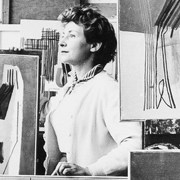
(1920-2005)
The Gallery represents the Estate of the artist Huguette Arthur Bertrand since 2012.
An important artist of Lyrical Abstraction, Huguette Arthur Bertrand is an active member of the post-war Parisian art scene, rubbing shoulders with Pierre Soulages, Hans Hartung, Serge Poliakoff, Jean Dewasne, Martin Barré and Pierre Dmitrienko among many others.
Exhibitions
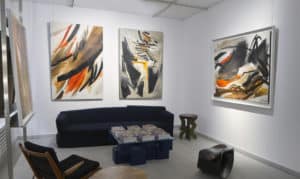
HUGUETTE ARTHUR BERTRAND
SOLO SHOW
MARCH 23 – JUNE 16, 2018
Publications

HUGUETTE ARTHUR BERTRAND – ROBERT HELMAN
LE PAYSAGE IMAGINAIRE
Digital publication – Text by Mathilde Gubanski

WOMEN IN ABSTRACT ART:
FIVE WOMEN – FIVE ARTISTIC VISIONS
Digital publication – Text by Mathilde Gubanski
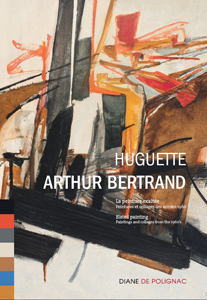
HUGUETTE ARTHUR BERTRAND
ELATED PAINTING
PAINTINGS AND COLLAGES FROM THE 1960S
Digital publication – Text by Astrid de Monteverde & Mathilde Gubanski
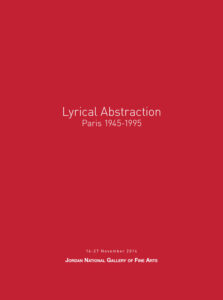
LYRICAL ABSTRACTION
PARIS 1945-1995
Published by the Galerie Diane de Polignac and the Jordan National Gallery of Fine Arts
Exhibition Catalog
English – 21 pages – nov. 2014
Videos
Artwork Analysis
“Huguette Arthur Bertrand, Cela qui gronde”, an analysis by Astrid de Monteverde
A young woman painter in Post-war Paris
Born in 1920 in Écouen, Huguette Arthur Bertrand spent her childhood in Roanne (center south of France) and settled in Paris shortly after the war. She attended the Académie libre de la Grande Chaumière. A fellowship allowed her to spend a year in Prague between 1946 and 1947 where she had her first solo exhibition. She met the painter Joseph Sima there.
A rare painter woman in the essentially masculine artistic landscape of Post-war Paris, she immersed herself fully in the buzzing art world of Montparnasse and Saint-Germain-des-Prés. Huguette Arthur Bertrand became friendly with publishers, critics (Michel Ragon) and abstract artists, those of the Galerie Denise René: Jean Dewasne, Jean Deyrolle, Serge Poliakoff; and with Martin Barré, Pierre Dmitrienko, James Guitet, Kumi Sugaï and John F. Koenig. On Saturdays she would visit Jean-Michel Atlan’s studio with Marcelle Loubchansky. She participated with passion in this artistic effervescence, marked by lively debate between figurative and abstract art, but also between supporters of “cold” abstraction and those of “warm” abstraction: one geometric, the other gestural, lyrical, guided by a free and spontaneous gesture.
In the 1950’s, Huguette Arthur Bertrand’s success in Paris
During the 1950s, Huguette Arthur Bertrand applied the full force of her art and the confidence of her artistic vocabulary made from stripes that hatch, streak, give rhythm to compositions. A powerful way of painting that confuses. A solid form of painting that marks a determined, independent character, “a type of painting that does not appear feminine at all; even muscular painting, strong, dynamic in a way that would appear masculine […]” as Michel Ragon wrote.
The woman artist Huguette Arthur Bertrand’s explosive work, which was definitively abstract from 1950, presents an audacious palette, full of colour that gradually evolved towards more dramatic shades, concentrated in a range of ochre, brown, orange-red.
In 1949 and 1950, Huguette Arthur Bertrand participated in the key exhibition Les Mains Éblouies (The Dazzled Hands) at the Galerie Maeght alongside Pierre Dmitrienko, and with Cobra artists in 1950 (Pierre Alechinsky, Corneille, Jacques Doucet).
In Paris, from the start of the 1950s, several galleries exhibited the painter woman’s work: Galerie Niepce, Galerie La Roue, Galerie Arnaud above all…
Huguette Arthur Bertrand regularly participated in the main salons of abstract art in Paris, at the Salon de Mai from 1949 until the late 1980s, at the Salon des Réalités Nouvelles until the 1990s, and at the Salon d’Automne.
The year 1955 was decisive for her: she won the famous Prix Fénéon (Fénéon award).
In 1956, Huguette Arthur Bertrand participated in the Festival de l’Art d’Avant-Garde, a major event held at Le Corbusier’s Cité Radieuse in Marseille.
Huguette Arthur Bertrand’s international recognition
Her works began to travel abroad: a solo exhibition was held at the Brussels Palais des Beaux-Arts in 1956, and crossed the Atlantic: in 1956, the Meltzer Gallery in New York organized for the woman artist a solo exhibition in 1956, praised by critics, then a group show the year after: North and South Americans and Europeans. Also in 1957, the painter Huguette Arthur Bertrand participated in the exhibition New Talents in Europe at the University of Alabama. In 1958 and in 1960-61, she exhibited at the Howard Wise Gallery in Cleveland.
The works of the painter woman Huguette Arthur Bertrand continued to be exhibited in many different galleries and art events all over the world: in Germany, Austria, Belgium, the Netherlands, Denmark, England, Italy… as far as Japan, Venezuela, Mexico and Cuba.
In 1962, Jean-Marie Drot interviewed Huguette Arthur Bertrand in her studio as part of L’oeil d’un critique program, directed for French television (ORTF).
The woman artist Huguette Arthur Bertrand in Michel Ragon’s circle of friends
Close to the art critic, Michel Ragon, the woman artist met his circle of friends: Pierre Soulages, Hans Hartung, Gérard Schneider, Zao Wou-Ki, Victor Vasarely, among others. Together they worked on a collection La Peau des Choses (the skin of things), a portfolio of prints published in a limited edition by Jean-Robert Arnaud in 1968 in honour of their friend Michel Ragon.
Huguette Arthur Bertrand’s maturity work
Starting in 1971, Huguette Arthur Bertrand worked with tapestry for over a decade (she received commissions from the Mobilier national) and became interested in monumental mural painting. At the turn of the 1980s, her gestures became more and more liberated, and calmer, summarized in subtle white traces, airy like a breath on the canvas. The woman artist Huguette Arthur Bertrand died in 2005.
© Diane de Polignac Gallery / Astrid de Monteverde
Translation: Jane Mac Avock
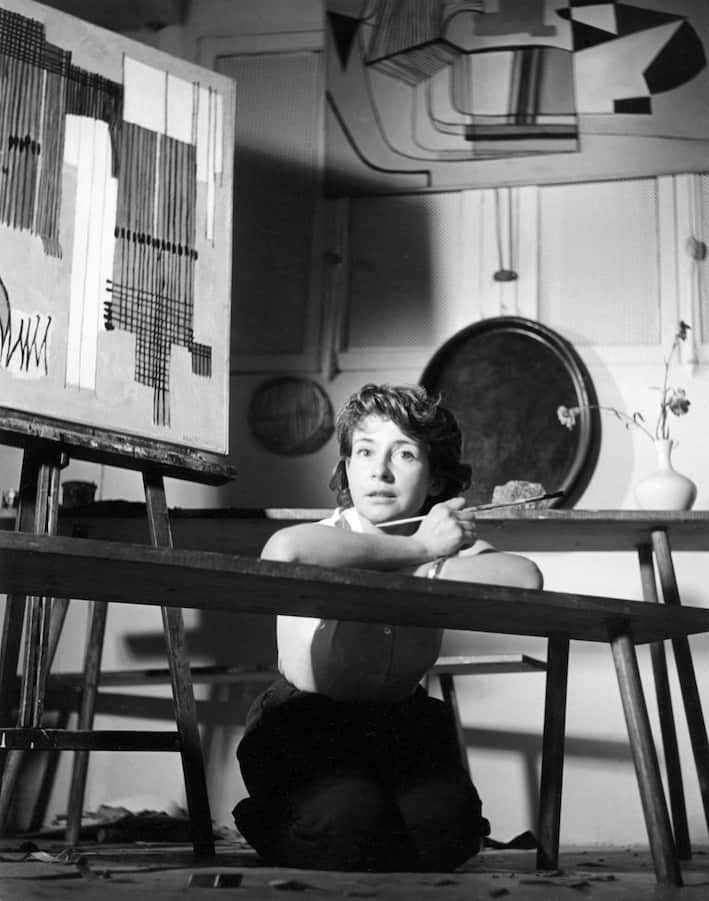
SELECTED COLLECTIONS
Selected Collections
Aalborg (Danemark), Museum of Modern Art
Angers, Musée Jean Lurçat et de la tapisserie contemporaine
Dunkerque, Lieu d’Art et d’Action Contemporaine (LAAC)
Geneva, Fondation Gandur pour l’Art
Minneapolis, Walker Art Center
Nantes, Musée d’arts
Oslo, Fondation Moltzau
Paris, Musée national d’Art Moderne, Centre Georges-Pompidou
Paris, Musée d’Art Moderne de la Ville de Paris
Paris, Bibliothèque nationale
Paris, Mobilier national
Paris, Centre national d’Arts plastiques (CNAP)
Québec, Musée des Beaux-Arts de Québec
Saint-Étienne, Musée d’Art moderne et contemporain de Saint-Étienne
SELECTED EXHIBITIONS
Selected Exhibitions
Les Mains éblouies (The Dazzled Hands), Galerie Maeght, Paris, 1949, 1950
Salon de Mai, Paris, 1949-late 1980s
Salon des Réalités Nouvelles, 1950-1990
Solo exhibition, Galerie Niepce, Paris, 1951
Salon d’Octobre, Paris, 1952-1953
Solo exhibitions, Galerie Arnaud, Paris,1953-1957
Wiener Secession, Vienna, 1954
Divergences, group shows, Galerie Arnaud, Paris, 1954-1957
Galerie Saint-Laurent, Brussels,1955,1956
Group show, Galerie Kleber, Paris,1955
Salon d’Automne, Lyon,1955
Éloge du Petit Format, group shows, Galerie La Roue, Paris, 1955, 1956
Salon Comparaisons, Paris,1956,1957
Galerie L’entracte, Lausanne,1956
10 Peintres de l’École de Paris, group show, Galerie de France, Paris, 1956
L’Aventure de l’Art Abstrait, group shows, Galerie Arnaud, Paris, 1956
Festival de l’Art d’avant-garde, Unité d’Habitation Le Corbusier, Marseille, 1956
Solo exhibition, Meltzer Gallery, New York, 1956
Solo exhibition, Palais des Beaux-Arts, Brussels, 1957
Biennale 57, Pavillon de Marsan, Paris, 1957
Biennale de Menton, Menton, 1957
Turin Biennale, Turin, 1957
Group show, (Expression et non-figuration, then Gouaches et collages), Galerie Le Gendre, Paris, 1957
Festival de l’Art d’avant-garde, Unité d’Habitation Le Corbusier, Nantes, 1957
Dialogue franco-allemand, Inge Allers Galerie, Mannheim (Germany), 1957
Triennale de l’art français, Musée des Arts décoratifs, Paris, 1957
Festival de l’art d’avant-garde, Berlin, 1957
50 ans de peinture abstraite, group show, Galerie Creuze, Paris, 1957
North and south Americans and Europeans, group show, Meltzer Gallery, New York, 1957
New talents in Europe, group show, Alabama University, Tuscaloosa (United States), 1957
Birch Gallery, Copenhagen, 1958
Parnass Galerie, Wuppertal (Germany), 1958
Six from Paris, group show, Galerie Howard Wise, Cleveland (United States), 1958
La Escuela de París, Museo de bellas artes, group show, Caracas (Venezuela), 1959
Peinture française contemporaine, group show, Museums of Copenhagen, Vienna, Linz, Dortmund, 1959
Expressions d’aujourd’hui, group show, Château de Lunéville, Lunéville (France), 1960-1961
50 peintres des Réalités Nouvelles, group show, Driand Gallery, London, 1960-1961
Present day Paris painting, group show, Howard Wise Gallery, Cleveland (United States), 1960-1961
Festival de l’Art d’Avant-garde, Pavillon américain, Porte de Versailles, 1960-1961
École de Paris, group show, Galerie Charpentier, Paris, 1960-1961
Solo exhibition, KK. Gallery, Copenhagen, 1962
Solo exhibitions, Galerie Argos, Nantes, 1962, 1971
Solo exhibition, Galerie Jacques Massol, Paris, 1964
50 ans de collage, group show, Musée de Saint-Étienne, Saint-Étienne et Musée des Arts Décoratifs, Paris, 1964
Acquisitions récentes de la Ville de Paris, group show, Musée d’Art moderne de la Ville de Paris, Paris, 1964
Promesses tenues, group show, Musée Galliera, Paris, 1965
L’École de Paris dans les collections au Luxembourg, group show, Musée de Verviers, Verviers (Belgium), 1965
50-57, une aventure de l’art abstrait, group show, Musée Galliera, Paris, 1967
Biennale de la gravure de Bradford, Bradford (United Kingdom), 1968
La part des Femmes dans l’Art contemporain, group show, Centre Culturel d’Ivry, Ivry-sur-Seine (France), 1984
Peinture abstraite des années 1950, group show, Château de Jau, Perpignan, 1984
Charles Estienne et l’Art à Paris, 1945-1966, group show, CNAP, Fondation Rothschild, Paris, 1985
Les années 50, group show, Musée d’Art contemporain de Dunkirk, Dunkirk and Musée de Besançon, Besançon, 1985
Architextures, exposition de Tapisseries, group show, École nationale supérieure des beaux-arts de Paris, Paris, 1985
Solo exhibitions, Galerie Galatée, Paris, 1987, 1990
L’art en Europe, les années décisives, group show, Musée d’Art moderne Saint-Étienne, Saint-Étienne, 1987
Solo exhibition, Treffpunk Kunst, Saarlouis (Germany), 1988-1989
Aspects de l’Art abstrait des années 1950, traveling group show: Foyer de l’Opéra, Lille; Vieille église Saint-Vincent, Bordeaux; Auditorium Maurice Ravel, Lyon; Chapelle Saint-Louis, Rouen; Hôtel-Dieu Saint-Jacques, Toulouse; Musée Hébert, Grenoble; Palais de la Bourse, Nantes; Casino Municipal, Royat; Mairie de Nancy, 1988-89
Solo exhibitions, Galerie Arnoux, Paris, 1990, 2005, 2008, 2010
Solo exhibition, Maison des Arts et des Loisirs, Sochaux (France), 1991
Comparaison France-Japon, Grand Palais, Paris, 1992
Solo exhibitions, Galerie Olivier Nouvellet, Paris, 1992, 1993, 1997, 2008
Salon Grands et jeunes d’aujourd’hui, Paris, 1992-1995
L’École de Paris 1945-1975, UNESCO, Paris, 1996
Les Années de combat. Le renouveau des Arts vu de Paris, group show, Galerie Arnaud and Cimaise jounal, Salle Chemellier, Angers, 1999
L’Envolée lyrique (Lyrical Flight), Paris 1945-1956, group show, Musée du Luxembourg, Paris, 200
Divergences / convergences, group show, Musée de l’Orangerie, Versailles, 2006
Réalités Nouvelles, group show, Galerie Drouart, Paris, 2006, 2008
Huguette Arthur Bertrand, retrospective, Maison des Princes, Pérouges (France), 2007
Les Années 50, group show, Banque Courtois, Toulouse, 2007
Atelier 3, Tapisseries, group show, Musée Jean-Lurçat et de la Tapisserie contemporaine, Angers, 2008
Aspect de l’Art en France 1950-1970, La Collection Allemand, traveling group show: Musée de Beauvais, Beauvais, 2008; Maison des Princes, Pérouges (France), 2010; Siège du Crédit Agricole, Luxembourg, Luxembourg, 2011
Les Sujets de l’abstraction, Peinture non-figurative de la Seconde École de Paris (1946-1962), (The Subjects of Abstraction, Non figurative Painting of the Second School of Paris [1946-1962]), group show, Fondation Gandur pour l’Art, Musée Rath, Geneva, 2011
Huguette Arthur Bertrand, Donation et autres œuvres, Musée des Beaux-Arts, cabinet d’arts graphiques, Angers, 2011-2012
Solo exhibition, Galerie Bertrand Trocmez, Clermont-Ferrand, 2012
Huguette Arthur Bertrand, solo show, Pavillon des Arts Décoratifs, Paris, Galerie Diane de Polignac, 2012
Abstractions 50, l’explosion des libertés, Atelier Grognard, Rueil Malmaison, 2014
Abstraction Lyrique Paris 1945-1955, Galerie Nationale des Beaux arts de Jordanie, Amman, 2014
Collection Annick et Louis Donat, town hall 8ème , Paris, 2015
Artapestry 3, Musée Jean Lurçat, Angers, 2015
The second sex women artists in post war Paris, Hanina Gallery, London, 2018
Huguette Arthur Bertrand, Galerie Diane de Polignac, Paris, 2018
Collages hommage, Guy Resse et la Galerie La Roue, Galerie Convergence, Paris, 2019
Femmes années 1950. Au fil de l’abstraction, peinture et sculpture (Women of the 1950s. Through abstraction, painting and sculpture), group show, Musée Soulages, Rodez, 2019-2020
Huguette Arthur Bertrand : La peinture exaltée, Peintures et collages des années 1960 (Elated painting, Paintings and collages from the 1960’s), Galerie Diane de Polignac, Paris, 2020
WOMEN IN ABSTRACT ART : Five women – five artistic visions, Galerie Diane de Polignac, Paris, 2021
Huguette Arthur Bertrand – Robert Helman Le paysage imaginaire, Galerie Diane de Polignac, Paris, 2023
SELECTED BIBLIOGRAPHY
Selected Bibliography
Michel Ragon, Une aventure de l’art abstrait, Paris, Laffont, 1956
Hubert Juin, Seize peintres de la Jeune École de Paris, Le Musée de Poche, Paris, Georges Fall, 1956
Michel Seuphor, Dictionnaire de la peinture abstraite, Paris, Hazan, 1957
Bernard Pingaud, Huguette Arthur Bertrand, monograph, Paris, Hoffer, 1964
Michel Seuphor and Michel Ragon, L’art abstrait, Paris, Maeght, 1973
Michel Ragon, Huguette Arthur Bertrand, followed by Notes de parcours du peintre, monograph, Paris, Porte du Sud / Galarté, 1987
Geneviève Bonnefoi, les années fertiles, 1940-1960, Paris, Perrin, 1988
Lydia Harambourg, L’école de Paris 1945- 1965 : dictionnaire des peintres, Lausanne, Ides et Calendes, 1993
Patrick-Gilles Persin, L’Envolée lyrique Paris 1945-1956, exhib. cat., Paris, Musée du Luxembourg (April 26 – August 6, 2006), Milan, Skira, 2006
Lydia Harambourg, L’École de Paris, 1945-1965, Dictionnaire des peintres, Ides et Calendes, Neuchâtel, 1993, (update by Clotilde Scordia, Ides et Calendes, Neuchâtel, 2010)
Éric de Chassey (dir.), Éveline Notter (dir.), Justine Moeckli and other, Les sujets de l’abstraction. Peinture non-figurative de la seconde école de Paris, 1946-1962. 101 Chefs-d’œuvre de la Fondation Gandur pour l’Art, exhib. cat., Geneva, Musée Rath (May 6 – August 14, 2011) / Montpellier, Musée Fabre (December 3rd, 2011 – March 25, 2012), Milan, 5 continents, 2011
Benoît Decron (dir.), Sabrina Dubbeld, Philippe Bouchet and other, Femmes années 1950. Au fil de l’abstraction, peinture et sculpture, exhib. cat., Rodez, Musée Soulages (December 14, 2019 – May 10, 2020), Paris, Hazan, 2019
Huguette Arthur Bertrand Faq
On the HUGUETTE ARTHUR BERTRAND FAQ page, find all the questions and answers dedicated to the modern art painter Huguette Arthur Bertrand.












